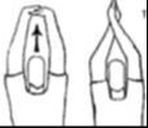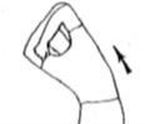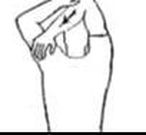STRETCHING3 Upper Body Stretches You
Should do Before, During and After Every Shift Arm & Shoulder Stretch
Stretch your arms out
upwards and rotate your hands until your palms are stacked. Hold this position for 10 seconds. Rotate your palms until your fingers are pointing up and palms are facing each other. Hold this position for 10 seconds and repeat on the other side. Waist & Back
Stand up and reach above the head with both arms.
Bend arms and hold the elbow of the opposite arm. Lean over to the one side. Hold for between 10 seconds, then change sides. Tricep Stretch
Raise your left arm straight overhead, then bend it so your left hand is on the middle of your upper back.
Your biceps and forearm should be touching. Reach over with your right hand and grasp your left elbow on the top, so your right palm faces down. Pull your left elbow gently toward your right side until you feel a stretch in your left triceps. Hold the stretch for 10 seconds and repeat on the other side. |
THE CIRCLE CHECK
|
HOURS OF SERVICE |
|
1. Daily requirement
- A driver must have 10 hours off-duty in a day. - A driver cannot drive more than 13 hours in a day. - A driver cannot drive after 14 hours on-duty in a day. 2. Mandatory off-duty time - After a period of at least eight hours off-duty, a driver cannot drive more than 13 hours. - After a period of at least eight hours off-duty, a driver cannot drive after having been on-duty for 14 hours. - After a period of at least eight hours off-duty, a driver cannot drive after 16 hours has elapsed. 3. Cycle requirement - An operator shall designate a cycle for the driver to follow. - There are two cycles available, a seven-day cycle or a 14-day cycle. - In a period of seven consecutive days, a driver cannot drive after having been on-duty for 70 hours. - In a period of 14 consecutive days, a driver cannot drive after having been on-duty for 120 hours. - -- - Drivers following this cycle shall not drive after accumulating 70 hours on-duty without having t taken 24 consecutive hours of off-duty time. - On any day, all drivers must have a period of at least 24 consecutive hours off-duty in the preceding 14 days. |
4. Cycle reset/switching
- A driver may only switch the cycle they are on if they start a new cycle. - To start a new cycle, a driver on the seven-day cycle must take 36 consecutive hours off-duty. - To start a new cycle, a driver on the 14-day cycle - Must take 72 consecutive hours off-duty. 5. Daily log requirement - A daily log may be handwritten, computer generated or made by means of a recording device. - The daily log must contain the following information:
|
Putting
|

B O O S T Y O U R C O N F I D E N C E
Boosting your level of confidence is an important aspect of feeling good, it ensures you are always putting our best foot forward. 1. Dress to Impress - freshen yourself up and dress in work appropriate attire. 2. Speak Polity - Always address co-workers and employers in a respectful manner. 
O O S T Y O U R P R O D U C T I V I T Y
Doing well at work will come naturally if you have taken care of yourself. You will have the energy to complete your tasks up to standards and ina time efficient manner. You will end each day proud of your work and the effort you put forth. 1. Punctuality - Arrive on time and ready to work for every shift. 2. Set Goals - Complete all tasks up to standards and efficiently. Employers recognize and appreciate this type of dedication. |

BO O S T Y O U R
H E A L T H Feeling good is the difference between having a good day or a bad day.When you feel healthy and strong you will feel excited in a good way and ready to take on the day. 1. Get Proper Sleep - 7 to 9 hours is recommended. 2. Eat Healthy - Bring healthy snacks for the road. 3. Exercise - Try to get 20 minutes of physical activity everyday; walk 10 laps around your truck during your break. The tips provided should be used as a guide for putting yourself first. Taking care of yourself will improve your confidence, energy level, and productivity. Start today and feel the difference.
|
AROUND THE CLOCK staffing and logistics diligent in our workAt Around The Clock Staffing Solutions, our reputation is one of achieving success through diligent research and finding the right understanding between employee and employer. We believe skilled and conscientious applicants deserve the job they are seeking as employers deserve the best applicants available. Our logistics department is second to none. We believe that success can actually come easily, you just have to work hard at it.
|
LATEST JOBSPosted April 6, 2018
Apply | More Info » |
